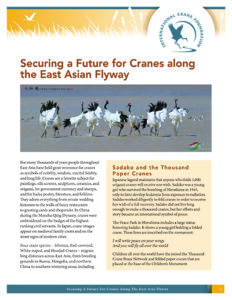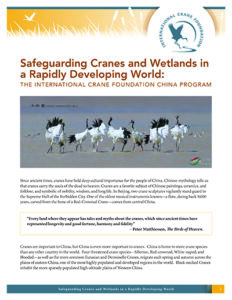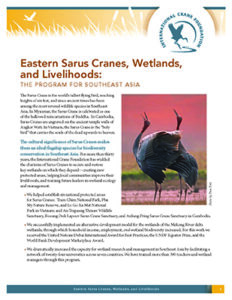

Asia
Issue
East Asia is home to eight crane species, the most of any region. Five of these species are threatened – Siberian, Red-crowned, White-naped, Hooded and Black-necked Cranes. Intense land and water development pressures due to rapid economic growth threaten wetlands of vital importance to crane survival in this region.
South and Southeast Asia are home to Sarus Cranes, as well as Black-necked Cranes, and wintering Demoiselle and Eurasian Cranes. Vulnerable Sarus Cranes face a myriad of challenges across their range, including loss of wetlands due to agricultural development and reduced water flows, as well as egg removal, power line collisions, pesticide poisoning and other direct threats.
Photo by Zheng Zhongjie
View our From the Field Webinar playlist: Securing the East Asian Flyway for Endangered Cranes.
Solutions
Our work builds on the strong cultural ties to cranes in East Asia, to engage local communities, resource managers, scientists and policymakers in the conservation of protected areas and their surrounding landscapes.
In addition, strong cultural ties to cranes and wetlands in India, Nepal, Cambodia and Vietnam provide unique opportunities to engage people in the conservation of these intensely settled landscapes using the Sarus Crane as a flagship species, which in turn also benefits local communities and other species.
Our work includes:
Photo by David Diserens
View our From the Field Webinar playlist: The Sarus Crane Landscape from South/Southeast Asia to Australia.
Ensure healthy populations of Red-crowned, White-naped, Hooded and Siberian Crane populations in the Amur-Heilong Basin of Russia and China. We are:
- Supporting the development and implementation of water management plans that sustain crane habitats and preserve wetlands for wildlife, flood control, enhancement of water quality, fisheries and other harvests important to people at Zhalong, Momoge, Xianghai, Tumuji, Muraviovka and other key crane wetlands.
- Developing pilot projects in China and Russia that demonstrate community involvement with wetland conservation.
- Promoting cooperative research efforts between crane conservationists in Mongolia and the Amur-Heilong basin of Russia and China.
- Conducting environmental education activities among communities and stakeholders affecting critical crane habitats to increase local and national pride and commitment to conservation action.
Supporting increasing winter populations of Siberian, White-naped and Hooded Cranes and maintaining the extraordinary diversity of other waterbird species in Poyang and nearby lakes in southeastern China. We are:
- Determining the effects of different water management scenarios on cranes and their aquatic plant food base.
- Promoting ecosystem approaches to management, including strategies to manage degradation caused by water infrastructure and economic development within its basin.
- Collaborating with Chinese agencies, researchers and local communities to demonstrate how fisheries management and crane protection go together.
- Supporting efforts by management agencies and partners to identify and restore alternative wintering sites for cranes in southern China.
Expanding the size and range of Black-necked Crane populations in western China. We are:
- Supporting pilot projects to reduce degradation around key wetlands through alternative livelihoods and agriculture practices.
- Undertaking long-term monitoring of selected breeding areas to assess the impacts of climate change on cranes and key wetlands, and to develop measures for adaptation to climate change.
- Strengthening environmental education efforts at Cao Hai and Ruoergai, using these efforts as a model to increase community awareness and pride in crane conservation in other areas of China.
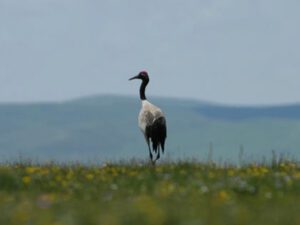
Photo by Qian Fawen
Securing the Sarus Crane population in South Asia through community-supported conservation practices and governmental policies that maintain the rich biodiversity of agricultural landscapes. We are:
- Reducing threats to Sarus Crane populations from powerline collisions, illegal conversion of wetlands, and poisoning by agricultural and industrial chemicals.
- Supporting a demonstration site at Lumbini, the birthplace of Buddha, to showcase the Terai landscape of Nepal used by Sarus Cranes and provide conservation education based on the Buddhist love for nature.
- Collaborating with village councils, farmers, and conservation partners to identify and implement strategies that preserve the agricultural and wetland landscapes supporting cranes and communities.
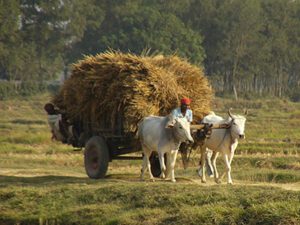
Supporting the growth of Southeast Asia’s population of Sarus Cranes through community-based conservation efforts and broader Mekong River initiatives to protect important wetlands. We are:
- Securing crane dry season habitats in the Mekong Delta and breeding habitats in northern Cambodia and Vietnam by strengthening conservation practices at existing crane sites and safeguarding small remnant wetlands that cranes could use.
- Continuing Mekong Delta community-based wetland and livelihood conservation programs and adapting these models to other important crane areas in Cambodia and Vietnam.
- Mentoring the development of the Mekong Wetland University Network to expand and diversify its contributions to critical wetland and crane status surveys in new areas such as Myanmar, to Mekong basin research, and to the training of conservation scientists from the Mekong countries.
- Assessing and mitigating impacts of large-scale river basin development and climate change on Sarus Cranes and wetlands in collaboration with other key partners in the region.
Monitoring the status of cranes and their habitats from South Asia to Australia and implementing conservation strategies to address emerging threats. We are:
- Enhancing and coordinating strategies for monitoring the status and threats for Sarus Cranes and their habitats in India, Nepal, Myanmar, Cambodia-Vietnam, and Australia.
- Monitoring wintering populations of Eurasian Cranes, Demoiselle Cranes, and Black-necked Cranes in South Asia and, with partners, identifying threat mitigation strategies to secure the future of these species.
- Using range-wide networking and periodic workshops to share information, and develop and test solutions to common threats in different crane landscapes.
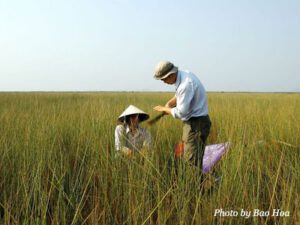
Partners
We work with numerous wetland nature reserves, relevant government agencies at national, provincial and local levels, research institutes and universities from throughout the region, local communities near the great crane places, and committed, highly active individuals who volunteer time and effort on behalf of cranes.




